Friends are the recognised guardians of Malvern's water heritage (Malvern Gazette 1 March 2013 p.14). The Friends is an independent voluntary group which relentlessly promotes research and celebration of Malverns Worldwide and the Springs, Spouts, Fountains and Holy Wells of the Malvern Hills, UK.
Malvern Appreciation Day 2017 - A celebration by Malverns Worldwide on Thursday 19th October.
In 2016, the mayor of Malverne New York, Patricia Norris-McDonald, declared the 19th October Malvern Appreciation Day. This was during a visit by Malverns Worldwide envoys Cora Weaver and Dr Bruce Osborne. The certificated Proclamation was presented to the envoys and can be viewed on the Malverne New York page of our web site as well as in the Council Offices in Great Malvern UK.
This year, Malverns Worldwide is celebrating the first anniversary of Malvern Appreciation Day with three Malverns joining the Malverns Worldwide project, following visits from our envoys. These are Malvern Pennsylvania, Malvern Warwickshire UK and Malvern Barbados. All three now have detailed information pages accessible from the index page of our web site.
The exchange of gifts is one way of extending the hand of friendship between Malverns. The gift from Senator Andy Dinniman, on behalf of Malvern Pennsylvania, was a state flag that formerly flew on the State Capital building. Later, the flag was conveyed to Chris O'Donnell, Chairman of Malvern Hills District Council. Coinciding with Malvern Appreciation Day 2017, this flag flew over the council offices in Priory Park, Great Malvern UK. A picture of the flag on the council offices is above.
The various gifts exchanged are displayed in a special cabinet at the Great Malvern Council Offices.
The Chantry Well 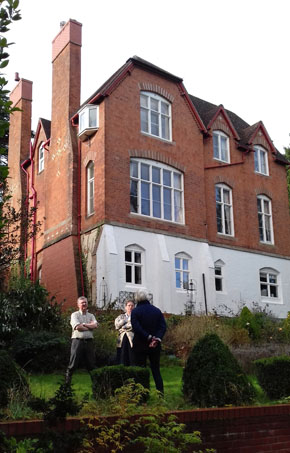
Recently we received an email from Friends who invited us to inspect a well that had been discovered in their house in Great Malvern, just to the south of the town centre. Following a site visit, Cora researched some of the background to the house and well, unearthing an interesting story.
The house is cut into the hillside and, during recent renovation by the current owners, the domestic well was discovered in the old laundry, which was built on the east side of the house so at the lowest level. The red-brick well has no mortar, enabling water to seep in, is 42 inches in diameter and probably no more than 10 feet deep because it is so close to the water table. In spite of there being springs immediately above the house, they were not used for the domestic supply in Victorian times when the house was built and occupied by a Miss Mytton.
Miss Bridget Anne Mytton (1815-1910) was brought up in Llandyssil, Montgomeryshire, where her father, Dusana Glynn Mytton, was the rector and her brother, Devereux, his curate. When her mother died in 1840, Bridget looked after the family, which was not for long. By 1867, she was quite alone, having lost her father, her brother Devereux, brother John and his wife and daughter, and her sister Elizabeth.
Circa 1864, Miss Mytton moved into The Virval, a newly-built, red-brick, Gothic-Revival house with features that might have been found in a rectory or the lodge of an ecclesiastical edifice, with its abundance of lancet-headed features, stained glass, quatrefoils and large polychrome brick crosses built into the south-facing exterior walls and visible to discerning passers-by in Woodshears Road. The architect, William Jeffrey Hopkins (1820-1901), was for many years the diocesan architect for Worcestershire and his work included the building and rebuilding of many churches in the county. He was a contemporary of Gothic Revivalists A. W. N Pugin (1812-52), S.S Teulon (1812-73) and E.W Elmslie (1818-89), all of whom left their creative mark in Malvern.
Why is it called the Chantry Well? At the end of November 1879, Miss Mytton moved back to her native Wales. Mrs Farrant and her family moved in and renamed the house The Chantry, the name by which it is still known.
Pictures above - Cora discusses the architecture of The Chantry with Sophia and her husband Peter, and Peter contemplates clearing the well of recent infill.
British Camp Reservoir to be reduced to a pond?
Change is always worrying but often has many advantages. Recent press editorial indicated that Severn Trent Water is seeking to drain the British Camp Reservoir. The large water area is a prominent landmark to the east of the Herefordshire Beacon. This facility for public water supply has been redundant for many years and obviously has maintenance cost. The current capacity is 213,000 cubic metres of water and this, it is thought, could usefully be reduced to a mere 8,000. The disused buildings on the site will be removed and the land returned to nature. The first question is will there be freedom to roam on the land so gained as it lies within the Malvern Hills AONB or will it become a potential development site?
The reservoir is supplied by a ring main that collects spring water from around the hills. The water for the fountain on Belle Vue Terrace is supplied from this. Do the changes proposed mean that the ring main will be similarly redundant and that water will no longer be taken from the springs? Or will the ring main continue to flow to the former reservoir site and become a brook that runs from the new pond along similar lines to the present arrangement? If the ring main is closed down, will springs now contained once more be open outfalls for the public to enjoy? There are also numerous springs and wells in the immediate area around British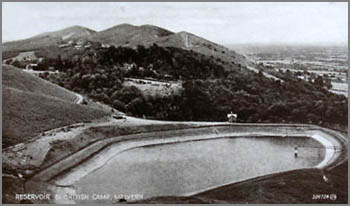 Camp and so presumably these will be unaffected. Some years ago, we rescued the Owls Hole pump and engine from the area and this could become an iconic artefact of what once was once a valuable facility for public piped water supply in the Malvern Hills.
Camp and so presumably these will be unaffected. Some years ago, we rescued the Owls Hole pump and engine from the area and this could become an iconic artefact of what once was once a valuable facility for public piped water supply in the Malvern Hills.
One recent suggestion is an energy source. Water flowing from the reservoir to a lower pond could be used to generate electricity, thus making it an energy store. The water is then returned to the higher level during off-peak times. Sounds interesting, but where would the lower pool be sited?
British Camp Reservoir was completed in 1894 and officially opened by the Duchess of Teck in April 1895. An early postcard picture is reproduced above. We await further developments with interest.
Have the Great British Spas lost the plot?
Do we really appreciate the value of our springs and wells in the Malvern Hills? A number of traditional British spas no longer have their natural spring waters available and this is causing concern and loss of tourism credibility.
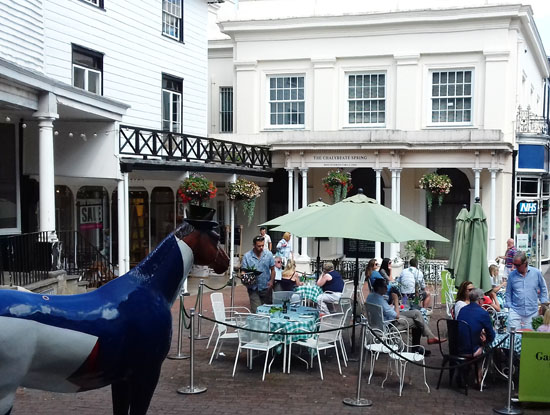
Tunbridge Wells, the world famous chalybeate spa; during a recent visit to test the waters proved to be dry. No longer does the water flow from the spring at the end of The Pantiles. Apparently, works higher up the hillside near the spa some years ago disturbed the water flow and as a result Tunbridge Wells has been left high and dry for two years now. Instead, a new tourism initiative appears to have replaced the traditional heritage spa attraction of the town. Daily Mail Tuesday 22 August - "Hundreds descend on Tunbridge Wells (of all places) for a sex party in a field, how behaviour once considered unthinkable is now depressingly common". Called Flamefest, several hundred attended the three day event reputedly in various states of undress. Ironically, the waters were once known for curing iron deficiency with ladies unable to become pregnant. Now there is emerging an alternative "cure". As they say: "It isn't the water that does what it ought to!" 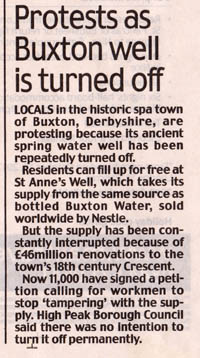
Picture above - The Pantiles chalybeate spring in the Colonnade but now the only drink is from the cafeteria.
Buxton, Derbyshire appears to have a similar situation. The ancient spring water at the Lion's Mouth has been repeatedly turned off. The supply has been constantly interrupted because of 48 million pound renovations to the 18th-century Crescent. Then 11,000 residents signed a petition calling for workmen to stop tampering with the supply. After High Peak Borough Council said there was no intention to turn it off permanently, there appeared a notice at the Well apologising for the lack of water and saying they are hoping to get it flowing again as soon as maintenance work is completed - the petition obviously had an effect. The good news is that the Pump Room is open again after a long closure - and work on the Crescent is well underway.
Thank goodness we have our extensive Malvern Waters in the hills around us. The lesson is that we need to take care of our springs and wells and ensure that water flows for visitors and residents to enjoy. The alternative appears to be public disappointment and different tourism initiatives, which may change the character of Malvern for ever. The choice is ours. Use it or lose it!
Picture right - is this recent press cutting what we want for Malvern as more springs are closed down?
Malvern Barbados joins the Malverns Worldwide Project 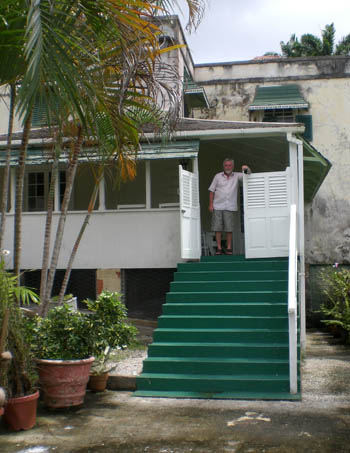
A recent visit by our international envoy Bruce resulted in the hand of friendship being extended to Barbados in the Caribbean. Malvern in Barbados is a township on the border of St John and St Joseph parishes, a short distance from the eastern coast. A former sugar plantation, it lies on a 250m plateau behind Hackleton's Cliff on similar latitude to Bridgetown, which is on the west coast. The principal building is the original Plantation House with the ruined sugar processing works opposite. The small township of modest residential properties and one tiny shop just down the road is also called Malvern. Such a township would have been the tenantry in earlier times, where single room huts were designated chattels and would be dismantled and moved with their slave occupants to and from the plantations. Today, the principal building, the Malvern Plantation House, is a Centre for Complementary Medicine. This was founded by June and Herbert Cheesman who purchased it in 1991. Much restoration was then carried out on the house, which itself had been extended and enhanced over the centuries.
 In the picture, Bruce awaits an audience with the Malvern House proprietor June Cheesman who manages a Centre for Complementary Health there. For many more details see the Malverns Worldwide Barbados web page:
In the picture, Bruce awaits an audience with the Malvern House proprietor June Cheesman who manages a Centre for Complementary Health there. For many more details see the Malverns Worldwide Barbados web page:
Great Malvern - We are not alone!
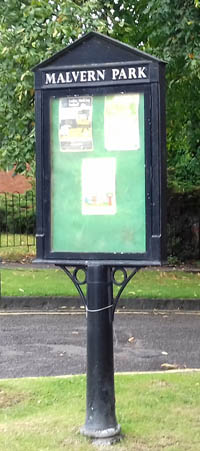 Little known to many Malvernologists is the presence of a second Malvern in the English Midlands. Situated in Warwickshire, we have been exploring the medieval past of this Malvern. What can be seen today in Warwickshire's Malvern? The Malvern Farm residence exists albeit as a private home and dates from the 16th century. Malvern Hall, a former stately home, is now St Martin's girl's school. Malvern House is a partially occupied commercial premises. Malvern Park is a large public recreation area. In addition, the parish church St Alphege's lies at the top of what was once known as Malvern Hill. Once a great estate, the land area has been subdivided over the centuries and now forms part of Solihull, an hour's drive from Great Malvern. So which Malvern came first? Was it Worcestershire or Warwickshire?
Little known to many Malvernologists is the presence of a second Malvern in the English Midlands. Situated in Warwickshire, we have been exploring the medieval past of this Malvern. What can be seen today in Warwickshire's Malvern? The Malvern Farm residence exists albeit as a private home and dates from the 16th century. Malvern Hall, a former stately home, is now St Martin's girl's school. Malvern House is a partially occupied commercial premises. Malvern Park is a large public recreation area. In addition, the parish church St Alphege's lies at the top of what was once known as Malvern Hill. Once a great estate, the land area has been subdivided over the centuries and now forms part of Solihull, an hour's drive from Great Malvern. So which Malvern came first? Was it Worcestershire or Warwickshire?
St Alphege, who is commemorated in the naming of the parish church, came from a noble Saxon family. He was brought up in the monastery at Deerhurst in Gloucestershire, rose to become Archbishop of Canterbury but was stoned to death by Danes in the year 1012. St Werstan, who founded Great Malvern Worcestershire, was contemporary with Alphege and was also from Deerhurst. Could it be that the second Malvern sought to adopt a saint with similar background to the original? The earliest evidence of a church on the Warwickshire Malvern site is not until 1220, based on dating the earliest portions of the present day church. St Alphege as patron saint dates from then, suggesting that the saint was adopted because of his similarity with the founder of Malvern Worcestershire, St Werstan.
A chantry, founded in 1277 alongside St Alphege's, was called Haliwell (Holywell), believed to be so named after a spring in the grounds. The chantry subsequently provided the foundation for the chapel of St Alphege on the north side of the church. Malvern Worcestershire has a Holywell in the Malvern Hills which is known to have been active in medieval times. Holywell gives further support to the hypothesis that Malvern Worcestershire was the inspiration for the founding of St Alphege's church and the establishment of the Malvern estate. There are also other clues. 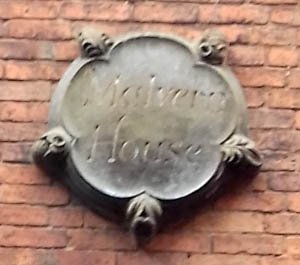
Evidence in the 14th century indicates that the name Malvern is associated with a Simon de Malverne (Assize Rolls 1317). A moated site opposite the end of Marsh Lane, Solihull, is believed to be de Malverne's former home. It lies within the boundaries of the Malvern House estate and was perhaps the predecessor of Malvern House that we see today. The bulk of the estate lies in the Manor of Longdon but does not appear as Malvern in the Domesday records circa 1086, suggesting that the Warwickshire Malvern post-dates Great Malvern. Was Simon's family origin Malvern in Worcestershire? If so, were they responsible for the adoption of the Malvern name in Warwickshire? There is also another strange aspect of the history. Both the Warwickshire and the Worcestershire Malverns appear to have roots with the same ownership source, the Beauchamps. This family line passed down to Madresfield Court in Great Malvern and the Warwickshire ownership was linked to Beauchamp's Court in Alcester. Our investigations continue.
Email: springs@thespas.co.uk (click here to send an email)



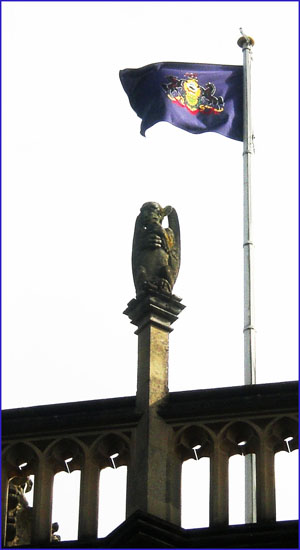

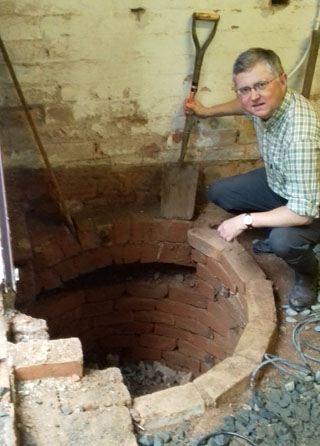
 Camp and so presumably these will be unaffected. Some years ago, we rescued the Owls Hole pump and engine from the area and this could become an iconic artefact of what once was once a valuable facility for public piped water supply in the Malvern Hills.
Camp and so presumably these will be unaffected. Some years ago, we rescued the Owls Hole pump and engine from the area and this could become an iconic artefact of what once was once a valuable facility for public piped water supply in the Malvern Hills.


 In the picture, Bruce awaits an audience with the Malvern House proprietor June Cheesman who manages a Centre for Complementary Health there. For many more details see the Malverns Worldwide Barbados web page:
In the picture, Bruce awaits an audience with the Malvern House proprietor June Cheesman who manages a Centre for Complementary Health there. For many more details see the Malverns Worldwide Barbados web page: Little known to many Malvernologists is the presence of a second Malvern in the English Midlands. Situated in Warwickshire, we have been exploring the medieval past of this Malvern. What can be seen today in Warwickshire's Malvern? The Malvern Farm residence exists albeit as a private home and dates from the 16th century. Malvern Hall, a former stately home, is now St Martin's girl's school. Malvern House is a partially occupied commercial premises. Malvern Park is a large public recreation area. In addition, the parish church St Alphege's lies at the top of what was once known as Malvern Hill. Once a great estate, the land area has been subdivided over the centuries and now forms part of Solihull, an hour's drive from Great Malvern. So which Malvern came first? Was it Worcestershire or Warwickshire?
Little known to many Malvernologists is the presence of a second Malvern in the English Midlands. Situated in Warwickshire, we have been exploring the medieval past of this Malvern. What can be seen today in Warwickshire's Malvern? The Malvern Farm residence exists albeit as a private home and dates from the 16th century. Malvern Hall, a former stately home, is now St Martin's girl's school. Malvern House is a partially occupied commercial premises. Malvern Park is a large public recreation area. In addition, the parish church St Alphege's lies at the top of what was once known as Malvern Hill. Once a great estate, the land area has been subdivided over the centuries and now forms part of Solihull, an hour's drive from Great Malvern. So which Malvern came first? Was it Worcestershire or Warwickshire?
 Newsletter Archive which can also be accessed from our WEB SITE INDEX.
Newsletter Archive which can also be accessed from our WEB SITE INDEX.




